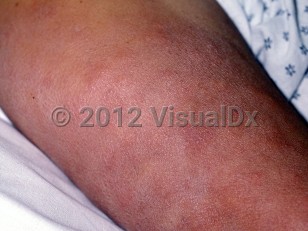Per the US Centers for Disease Control and Prevention (CDC), Central Florida has witnessed an increased incidence of leprosy cases. Because cases have lacked traditional risk factors (zoonotic exposure, recent residence outside of the United States), it is thought that leprosy may now be endemic in the southeastern United States. Travel to Florida should be considered when conducting leprosy contact tracing in any state.
Leprosy spreads via human-to-human transmission. Armadillos are also a reservoir, and direct contact with armadillos is thought to be a risk factor for development of leprosy. The average incubation period for M leprae is about 5 years, with a range from 2 to over 30 years.
Mycobacterium leprae has a predilection for the cooler parts of the body, skin, peripheral nerves, upper respiratory system, anterior eye chambers, and testes.
Leprosy is classified into 5 disease types based on clinical, immunologic, and pathologic criteria:
- Tuberculoid leprosy (TT)
- Borderline tuberculoid leprosy (BT)
- Midborderline leprosy (BB)
- Borderline lepromatous leprosy (BL)
- Lepromatous leprosy (LL)
Peripheral neuropathy may occur across the spectrum before, during, and after treatment. Small nerve fibers conveying fine touch, temperature, and pain sensations are the most impaired. During immune exacerbations (reactions), fever, arthralgias, neuritic pain, uveitis, and orchitis may occur.
Type 1 lepra reaction and erythema nodosum leprosum (type 2 lepra reaction) are 2 types of reactive states seen during alteration of the patient's immune response. They can occur before, during, or after therapy. Lucio phenomenon is a rare reaction seen in patients with multibacillary leprosy due to endothelial invasion of M leprae.
Mycobacterium lepromatosis is a newly identified mycobacterium that usually causes LL or diffuse LL. It has also been reported to cause BL, Lucio phenomenon, and erythema nodosum leprosum.



